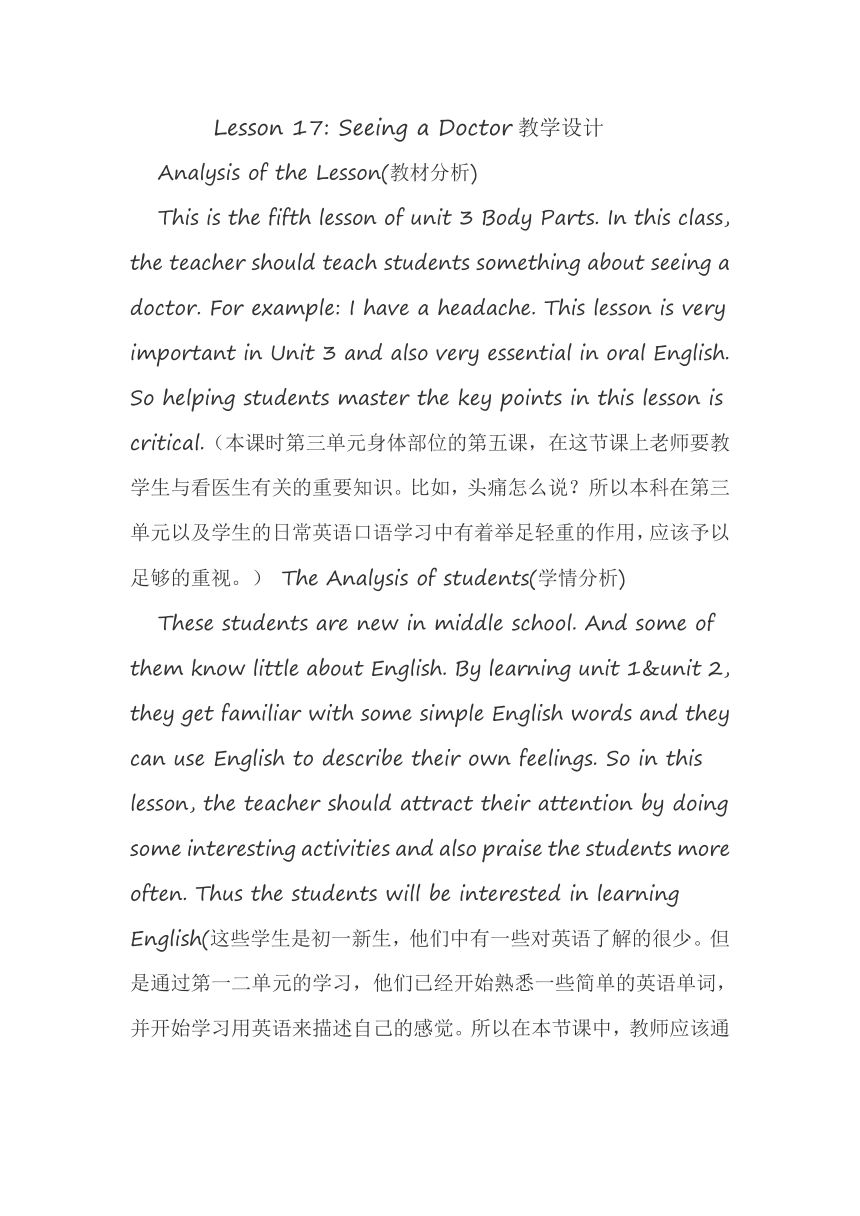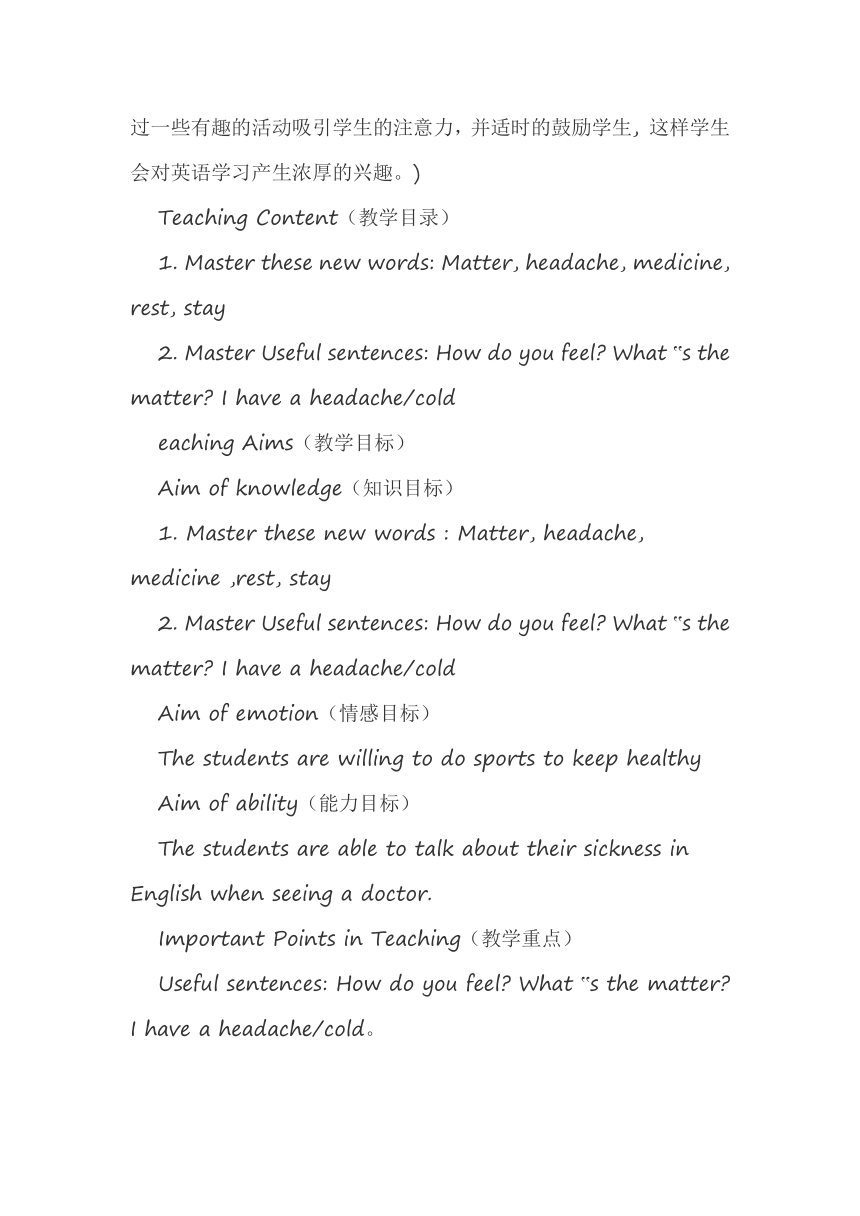冀教版七上英语Unit 3 Body Parts and Feelings Lesson 17 Seeing a Doctor 教案
文档属性
| 名称 | 冀教版七上英语Unit 3 Body Parts and Feelings Lesson 17 Seeing a Doctor 教案 |  | |
| 格式 | doc | ||
| 文件大小 | 33.5KB | ||
| 资源类型 | 教案 | ||
| 版本资源 | 冀教版 | ||
| 科目 | 英语 | ||
| 更新时间 | 2020-12-22 07:37:10 | ||
图片预览


文档简介
Lesson 17: Seeing a Doctor教学设计
Analysis of the Lesson(教材分析)
This is the fifth lesson of unit 3 Body Parts. In this class, the teacher should teach students something about seeing a doctor. For example: I have a headache. This lesson is very important in Unit 3 and also very essential in oral English. So helping students master the key points in this lesson is critical.(本课时第三单元身体部位的第五课,在这节课上老师要教学生与看医生有关的重要知识。比如,头痛怎么说?所以本科在第三单元以及学生的日常英语口语学习中有着举足轻重的作用,应该予以足够的重视。) The Analysis of students(学情分析)
These students are new in middle school. And some of them know little about English. By learning unit 1&unit 2, they get familiar with some simple English words and they can use English to describe their own feelings. So in this lesson, the teacher should attract their attention by doing some interesting activities and also praise the students more often. Thus the students will be interested in learning English(这些学生是初一新生,他们中有一些对英语了解的很少。但是通过第一二单元的学习,他们已经开始熟悉一些简单的英语单词,并开始学习用英语来描述自己的感觉。所以在本节课中,教师应该通过一些有趣的活动吸引学生的注意力,并适时的鼓励学生, 这样学生会对英语学习产生浓厚的兴趣。)
Teaching Content(教学目录)
1. Master these new words: Matter, headache, medicine, rest, stay
2. Master Useful sentences: How do you feel? What ?s the matter? I have a headache/cold
eaching Aims(教学目标)
Aim of knowledge(知识目标)
1. Master these new words : Matter, headache, medicine ,rest, stay
2. Master Useful sentences: How do you feel? What ?s the matter? I have a headache/cold
Aim of emotion(情感目标)
The students are willing to do sports to keep healthy
Aim of ability(能力目标)
The students are able to talk about their sickness in English when seeing a doctor.
Important Points in Teaching(教学重点)
Useful sentences: How do you feel? What ?s the matter? I have a headache/cold。
How to describe talk with a doctor in English when you are ill Difficult Points in Teaching(教学难点)
How to describe talk with a doctor in English when you are ill Teaching Aids(教学辅助工具)
A recorder, audiotapes, flashcards, films, markers Type of Teaching: Teaching Procedure(教学过程)
Step1. Warming up
Review: Express the feelings of yourself.
You can say like this: I?m happy. Are you happy, too? Are you hot 2
or cold? Let some students answer and ask questions like this. Step2. Presentation
By doing gestures help students guess “What ?s wrong with me ” And then ask students guess “what should I do?”
Step3.lead-in
By doing gestures tell students some words about sickness. Such as headache, cold, stomachache
Step4. Listening
Play the tape for students and ask them to listen to the tape and read after it until they can read it fluently and let them do part 1 in Let’s Do It Step5.reading
Ask students to read the text by themselves and answer the following questions
1. What ?s wrong with Jim?
2. What ?s wrong with Danny?
Step6.Explaination
Explain difficult points in the text
1. 表示“患病”的两种表达方式:
表达方式之一: My ___ hurt(s)
表达方式之二 : I have a(n) +部位+ache.
E.g. I have a headache=my head hurts
E.g. I have a stomachache =my stomachache hurts
2. You?d?d better=had better had better是情态动词,后跟动词原形 E.g. You'd better do your homework now
Step7 Consolidation
Help students do the exercises in part 2&3 in Let’s Do It
Step8. Oral practice
Let students work in pairs and use the sentences in part 4 in Let’s Do It to make up dialogues and ask volunteers come to the stage to act it out. Then choose the best pair and give them praise.
Homework
Finish off all the exercises of Lesson 17 in Exercise Book
Preview Lesson 18: We All Look Different!
Analysis of the Lesson(教材分析)
This is the fifth lesson of unit 3 Body Parts. In this class, the teacher should teach students something about seeing a doctor. For example: I have a headache. This lesson is very important in Unit 3 and also very essential in oral English. So helping students master the key points in this lesson is critical.(本课时第三单元身体部位的第五课,在这节课上老师要教学生与看医生有关的重要知识。比如,头痛怎么说?所以本科在第三单元以及学生的日常英语口语学习中有着举足轻重的作用,应该予以足够的重视。) The Analysis of students(学情分析)
These students are new in middle school. And some of them know little about English. By learning unit 1&unit 2, they get familiar with some simple English words and they can use English to describe their own feelings. So in this lesson, the teacher should attract their attention by doing some interesting activities and also praise the students more often. Thus the students will be interested in learning English(这些学生是初一新生,他们中有一些对英语了解的很少。但是通过第一二单元的学习,他们已经开始熟悉一些简单的英语单词,并开始学习用英语来描述自己的感觉。所以在本节课中,教师应该通过一些有趣的活动吸引学生的注意力,并适时的鼓励学生, 这样学生会对英语学习产生浓厚的兴趣。)
Teaching Content(教学目录)
1. Master these new words: Matter, headache, medicine, rest, stay
2. Master Useful sentences: How do you feel? What ?s the matter? I have a headache/cold
eaching Aims(教学目标)
Aim of knowledge(知识目标)
1. Master these new words : Matter, headache, medicine ,rest, stay
2. Master Useful sentences: How do you feel? What ?s the matter? I have a headache/cold
Aim of emotion(情感目标)
The students are willing to do sports to keep healthy
Aim of ability(能力目标)
The students are able to talk about their sickness in English when seeing a doctor.
Important Points in Teaching(教学重点)
Useful sentences: How do you feel? What ?s the matter? I have a headache/cold。
How to describe talk with a doctor in English when you are ill Difficult Points in Teaching(教学难点)
How to describe talk with a doctor in English when you are ill Teaching Aids(教学辅助工具)
A recorder, audiotapes, flashcards, films, markers Type of Teaching: Teaching Procedure(教学过程)
Step1. Warming up
Review: Express the feelings of yourself.
You can say like this: I?m happy. Are you happy, too? Are you hot 2
or cold? Let some students answer and ask questions like this. Step2. Presentation
By doing gestures help students guess “What ?s wrong with me ” And then ask students guess “what should I do?”
Step3.lead-in
By doing gestures tell students some words about sickness. Such as headache, cold, stomachache
Step4. Listening
Play the tape for students and ask them to listen to the tape and read after it until they can read it fluently and let them do part 1 in Let’s Do It Step5.reading
Ask students to read the text by themselves and answer the following questions
1. What ?s wrong with Jim?
2. What ?s wrong with Danny?
Step6.Explaination
Explain difficult points in the text
1. 表示“患病”的两种表达方式:
表达方式之一: My ___ hurt(s)
表达方式之二 : I have a(n) +部位+ache.
E.g. I have a headache=my head hurts
E.g. I have a stomachache =my stomachache hurts
2. You?d?d better=had better had better是情态动词,后跟动词原形 E.g. You'd better do your homework now
Step7 Consolidation
Help students do the exercises in part 2&3 in Let’s Do It
Step8. Oral practice
Let students work in pairs and use the sentences in part 4 in Let’s Do It to make up dialogues and ask volunteers come to the stage to act it out. Then choose the best pair and give them praise.
Homework
Finish off all the exercises of Lesson 17 in Exercise Book
Preview Lesson 18: We All Look Different!
同课章节目录
- Unit 1 School and friends
- Lesson 1 Hello!
- Lesson 2 Teacher and Students
- Lesson 3 Welcome to Our School
- Lesson 4 What Is It?
- Lesson 5 May I Have a Book?
- Lesson 6 Things for School
- Unit 2 Colours and Clothes
- Lesson 7 Jenny's New Skirt
- Lesson 8 Danny's Favourit Colou
- Lesson 9 Whose Coat Is This?
- Lesson 10 Clothes for a Cold Day
- Lesson 11 Clothes around the World
- Lesson 12 Let's Go Shopping!
- Unit 3 Body Parts and Feelings
- Lesson 13 Body Parts
- Lesson 14 Colours and Feelings
- Lesson 15 Tall or Short
- Lesson 16 Happy or Sad
- Lesson 17 Seeing a Docto
- Lesson 18 We All Look Different!
- Unit 4 Food and Restaurants
- Lesson 19 Time for Breakfast!
- Lesson 20 I Like the Supermarket!
- Lesson 21 At the Market
- Lesson 22 In the Restaurant
- Lesson 23 The Corner Store
- Lesson 24 Eat Good Food!
- Unit 5 Family and Home
- Lesson 25 Jenny's Family
- Lesson 26 Li Ming's Family
- Lesson 27 Danny at Home
- Lesson 28 A Family Picnic
- Lesson 29 A Birthday Card
- Lesson 30 Grandma's Birthday Party
- Unit 6 Let's Go!
- Lesson 31 Let's Go to the Bookstore!
- Lesson 32 At the Supermarket
- Lesson 33 Let's Go to the Zoo!
- Lesson 34 On the Farm
- Lesson 35 Let's Go to the Museum!
- Lesson 36 Let's Go to the Movie Theatre!
- Unit 7 Days and Months
- Lesson 37 Seasons and Weathe
- Lesson 38 Nick's Busy Month
- Lesson 39 A Class Calenda
- Lesson 40 When Is Your Birthday?
- Lesson 41 Holidays
- Lesson 42 Happy Holidays!
- Unit 8 Countries around the world
- Lesson 43 Directions
- Lesson 44 Jack's Goodbye Party
- Lesson 45 China
- Lesson 46 Canada and the U.S.
- Lesson 47 The U.K. and Australia
- Lesson 48 English-Speaking Countries
